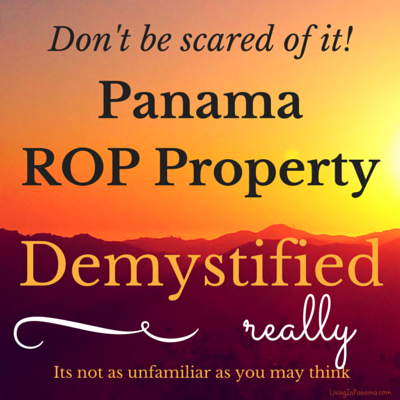
A little history may help.
In the beginning, land in Panama did not belong to anyone. The indigenous people used it collaboratively.
Then the Spanish came.
They declared all land in Panama belonged to the Spanish Crown. However, the Crown only cared about the land from Colon to Panama City - for the same reason it is valuable now, as a port for global trade.
In the interior, the Crown continued the communal tradition of Panama's indigenous people by selling some land to villages to be owned collectively. Some large tracts of land were also granted to favored subjects. On the rest, the Crown recognized the right of small farmers to use, but not own, as much land as they needed.
At that point it was a bit like feudal England. The Crown was fine with you using its land as long as you played nice and obeyed the King or Queen. And even after its grants and sales, almost all of the land in Panama remained untitled and in the Crown's domain.
Then, 300 years later, Spain left. All of that land now belonged to the new government.
Not Much Titling Going On
The new Panama government asked its citizens to title any land they were using by showing proof of their land claim. But very few bothered to do that.
Getting title was an expensive and long process. Even many of the wealthy folks didn't do it. That's because once you title, you must start paying property and capital gains taxes.
Titling today is much cheaper and somewhat faster. However, most land in Panama continues to be ROP with the government holding the title. So in many ways it continues today the way it did when Panama was a colony of Spain.
Of course, as we all know, even in North America with its almost 100% titled property, government can step in. Have you heard of Eminent Domain? Trump and Cruz were arguing about it in a debate a few months ago. That is, if the state needs your property they can come in and take it, with a "fair market" compensation, of course. Trump and Cruz were arguing whether it was okay for the government to take land to build a parking lot.
It means you can use the property any way you want, just as if you held title to the land. It means you own the right to use the land, just as if you had the title.
Except, because you don’t own the title, you don’t have to pay taxes.
Required Research
Since ROP properties are not registered with the State, you need to make sure that the person selling you the property really owns it. See this post on how to buy ROP property safely for more on how to do that.
To avoid doing that work, you can buy ROP land from someone like us who has done all that work for you. We go through an extensive investigative process to ensure that there is a clear ownership trial and collaborative documentation for all our ROP properties.
Required Maintenance
In addition to research, you have to go out and physically claim your property in a noticeable way. Something that says there are new owners of this property. We always recommend that you immediately put up a fence. If a fence is already there, paint the fence. At a minimum, have someone go out on a somewhat regular basis and keep the grass cut. Just something so everyone knows that the property is owned and cared for by you. You don't have to be there yourself, the fact that you are hiring someone to cut the grass is enough. Or you could build a rancho or some sort of structure.
You are establishing that you are the new owner, the person that holds the right to use the property. If there is ever a legal challenge, the court will ask for your proofs of ownership. That is when you pull out your evidence of activity.
We have been establishing ownership of our ROP property for years. We put up fences on all our properties and maintain them. We also get to know our neighbors. That isn't necessary, but it is a good idea for many reasons. My husband especially loves to chat with all the neighbors. He even knows the names of all their dogs. Because of this there is no doubt in anyone's mind about who owns those properties - we do. And that certainty of ownership is entirely passed on to you, when you buy our property.
Maintenance & Titled Property Keep in mind, you need to keep your eye on titled property too. If someone is using your land for 10 years in good faith (that is, they didn't know you owned it), they can get title. Or in 15 to 20 years if they are using it in bad faith (that is they know you own it, but decide to ignore that fact.)
Of course, that can happen in the States too.
My sister-in-law lost part of her land because for years she allowed a neighbor to garden a section of it. When she went to sell it, she faced a legal battle to keep that "garden" as part of her land. She lost. Her neighbor is still gardening that strip. My sister-in-law sold her property minus that section. She never got reimbursed for the loss.
You can avoid my sister-in-law's loss in both Panama and the US by simply having the people using your land sign a document. A document that states they are using the land on a temporary basis, or even better yet make it a rental agreement, even if only for a nominal fee. That precaution works for both ROP and titled land.
Pay No Taxes
ROP property is excluded from property taxes and all land transaction taxes (i.e., capital gains, transfer fee).
Learn more about Panama property taxes & exemptions here.
There is a big market for ROP property. It is routinely bought, sold, and traded - just like titled property.
You can just as easily earn a profit reselling ROP land as titled land.
In fact, some people prefer ROP to titled property. This is because, as I've mentioned, you don't have to pay property or capital gains tax with ROP property. In addition, ROP land tends to be cheaper than titled land.
As I alluded to in this post, some of the same kind of land issues with ROP (and titled) property in Panama occur in North America as well (think of my sister-in-law's property loss and eminent domain).
Now that you have a clearer understanding of what ROP means, you can decide if the benefits of ROP land outweighs the costs.
Which type of property are you looking to buy? Please share in comments below.
Check out these links to get our guide to titling Panama property . You can also read about 3 things you must do when you buy ROP property.
If you have questions, please feel free to call us or leave a comment below.
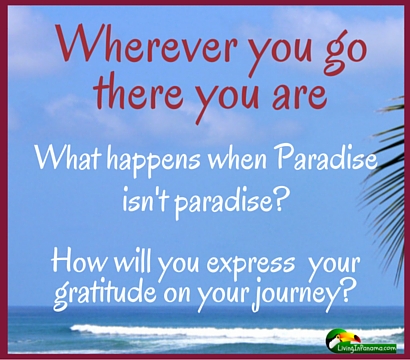
I hope that we have been clear, and honest with our readership in saying that the old saying, “wherever you go, there you are”, applies here too.
Puerto Armuelles, Panama is no different from anywhere else on the planet. What you bring to each day, is what you can expect to receive from each day.
One thing I am happy to notice in some of our recent arrivals to town is a serious, disciplined approach to their spiritual life. I do not refer to those who believe that the world is going to Hell, and that they need to find a place to hide out, and hoard scarce resources, so that they don’t have to share any.
I have spoken to a number of folks lately who talk about getting together for meditation practice, yoga, and non-denominational spiritual talks. There is even more talk about “giving back” or “paying it forward”, in the sense of a grateful recognition of all the gifts that we are being given each day, and a sincere desire to want to share our good fortune with others. I'm not saying that the old-time Puerto expat don't have those same goals, just that I am encountering a greater number of new people who are actively expressing those goals.
I think that living in another culture, as our family has in Panama for almost ten years, causes one to appreciate our good fortune to be able to experience this very simple lifestyle, and a low stress pace of life, which has allowed us to live several years within each calendar year. Time still passes for us. But, it doesn’t feel as if we are running frantically just to keep pace with our society. It is much, much slower here.
However, if you pay attention to poltics here it can be demoralizing. For instance, from reading the papers and speaking to locals, one realizes that the arrival of the Del Monte fruit company to take over banana production for our region may not take place all because of political influences that have nothing to do with the production of bananas, nor with the employment of hundreds, or thousands, of workers. The apparent reason for the possible non-signing of the contract with Del Monte, according to local experts, is that the favors being offered by Del Monte to the signatories here in Panama are not sufficient. (Although, now we hear it may actually get signed and approved. We will know when we learn that Del Monte is actually hiring people to work the banana plantations.)
I will say no more about the Del Monte negotiations. But the situation reminds me that I am very fortunate that my own livelihood is not dependent upon the good will of Panamanian politicians.
As an expat, whether you consider yourself wealthy or poor, you are automatically perceived by the vast majority of locals locals as visiting “rich and powerful elites”. It can be a bit unsettling when you realize this. But in reality even if we consider ourselves barely making it, we are most likely much better off that a big segment of the local population. So at least comparatively, you are well-off financially.
My questions today, of myself, and of all of us, are these:
What do we intend to do with all of our good fortune, or resources, our talents, and our connections? With all this time at our disposal in Panama, do we have a personal plan of action that includes working on the spiritual side of ourselves, and not just on the material? Do we have a plan of action that includes concrete steps to make life better for others less fortunate than ourselves? Or are we content to just make sure that we ourselves are safe and comfortable? I know it is a struggle to turn our focus away from ourselves and our family, but is it a valuable goal?
What are your thoughts?
March 26, 2016 by Skylar Vayda and Betsy Czark
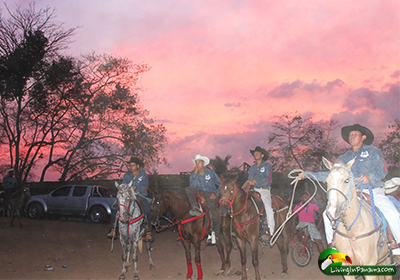
The Rodeo, or Pista de Lasso (as it is called in Panama) consists of lasso teams competing to lasso a calf in the shortest time possible. And definitely under 20 seconds, which is the maximum amount of time a cowboy has to lasso a calf within an 80 meter long space.
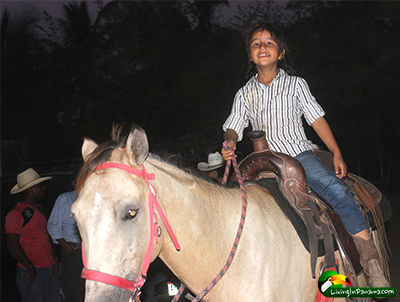
The rodeo begins at 11 am and goes into the evening. Because of this time frame, as the day progresses, some teams perform more poorly than others because one or more of their riders is drunk.
The rodeo's atmosphere is lively and at time intense, as the supporters of each team shout their encouragements. There is also a fair amount of unofficial bets being placed, so that may be something to look out for.
My (Skylar's) past experiences at the rodeo have been wonderful. I loved horses when I was younger. Because of that I especially enjoyed seeing the pure breed horses outfitted in their colorful harnesses. I went often when I was younger. I even owned my own lasso so I could practice. But I watched much more lassoing than I practiced.
The rodeo season is a large part of the culture in Panama. While in Panama you should definitely experience it at least once.
Puerto's Rodeo Schedule
Rodeos occur on 8 consecutive Sundays. The first rodeo was on March 6th.
The Pista de Lasso technically start at 10am, but usually don't get going until 11ish. Food and drinks are sold at the events.
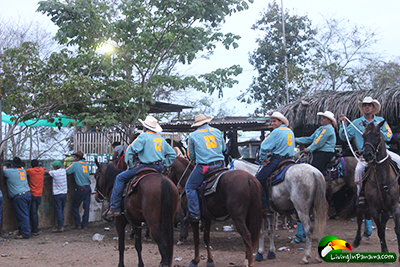
5 Remaining Competitions
March 27 - Location outside of Puerto Armuelles
April 3rd - Casa de Puma - located about 3 miles from downtown Puerto
April 10th - Location outside of Puerto Armuelles
April 17th - Romero Arena in Altos San Vicente neighborhood
April 24 - Location outside of Puerto Armuelles
There are a total of 10 teams competing in these rodeos. Four are from Puerto Armuelles. One of those teams is sponsored by 2 Puerto Armuelles expats & horse lovers: Veronica and Tony.
Do you want to be part of a team? You cannot just join, you must be invited. The teams are really clubs. To show your interest and prowess, you must go to the practice roping events that are held from November - February.
I will be updating this post soon. I want to impart the wealth of information about these events from Veronica and Tony.
I simply don’t have time to write it up now. But I wanted to get the rodeo schedule to folks in case they want to attend. Last Sunday, Skylar and I enjoyed ourselves at the rodeo in Altos San Vicente. The photos on this page are from that day.
March 26, 2016
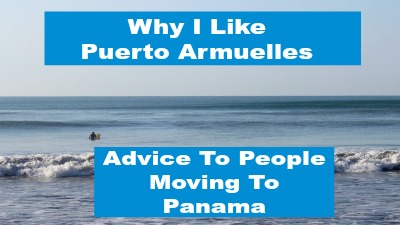
Originally, Victor said all of this in a video. However, Victor does not like the fame the video has given him, especially people recognizing him. He asked me to take the video down. I kept the interview transcription below.
It's peaceful. It is like Hawaii 40 - 50 years ago and I needed that kind of life. I drove down here, me and my dog and a few things and I've been here 2 and a half years now.
It is a great place. Puerto Armuelles is, like I said, like Hawaii 40-50 years ago. And that is what I wanted to find.
Some people like outside of Panama City, which is more like resorts and condos. If I wanted that, I might have well moved to Hawaii or California.
If you want to live with more local Panamanians and the culture and all that, I recommend Puerto Armuelles."
Victor
"I call it, you gotta create your own life. If you want to go to Starbucks or Macys or something- there is none of that here.
Life is simple."
Victor
"I wake up. Walk to the beach with my dog. Check if there are any waves or not.
If there are waves I go surfing.
If not, I come back home and do whatever. Make my hot chocolate, projects"...
Victor
"Learn some Spanish. I'm still really bad.
It's their country so respect their customs. Take it as an adventure."
Betsy - "Thanks Victor."
Victor
"Your welcome. De nada."
To learn more about Puerto Armuelles, start here.
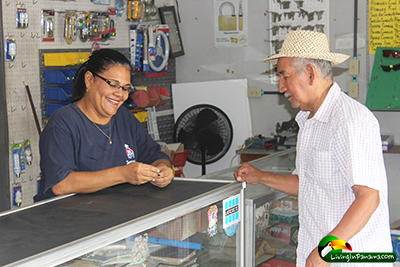
Remember when there used to be at least one “mom and pop” hardware store in every North American town, and dozens in a city? Sadly, most of these disappeared with the advent of home building supply super centers, such as Lowe’s and Home Depot.
Fortunately for us, the fast pace of life up north has not caught on in Puerto Armuelles yet. The family run hardware store (Ferreteria in Spanish) is still going strong in our town.
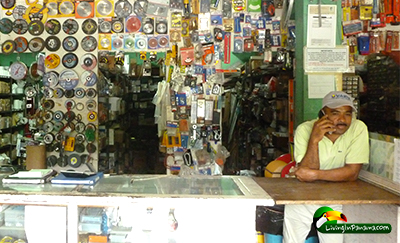
The local “ferreterias” are different from the small hardware store you may be used to. Our hardware stores sell absolutely everything that is required for constructing and maintaining a house (a Panamanian style house).
That is, they sell Cement, Concrete Block, Rebar, other Steel Sectional Shapes (such as angle, round tube, square tube), Sand, Gravel, Fill Dirt, Chicken Wire, Square Mesh, Rope, Chain, Adhesives, Sealants, Nails, all other hardware, Wiring, Paint, Knives, Machetes, Shovels, Picks, Hoes, Power and Hand Tools, etc. etc. etc….
Deliveries and Special Orders
Same day delivery of large, or heavy products is available. For instance, if you order ten meters of gravel, and fifty sacks of cement, they can usually be at your delivery address within a couple of hours, at no extra charge.
If one limits one’s desires to what a typical Panamanian lives in, one can find everything one needs right here in town. Often within only a 2-3 minute drive of one’s house or building site.
Check out these photos to get an idea of what a hardware store in Puerto Armuelles is like. These are photos of Casa Cheong. Click on any photo to enlarge and start the slideshow.
Below these photos, I mention my favorite hardware stores and the benefits of buying locally.
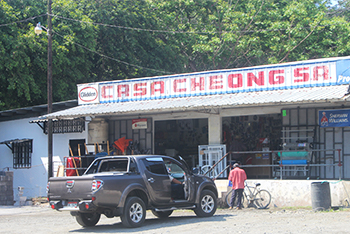
I have 3 favorite hardware stores:
Casa Cheong, right next to Romero’s supermarket at the North end of town. It is owned by Adriano Ching and ably run by store manager Daisy and her assistant Mari. Casa Cheong has a very friendly and helpful yard crew.
Materiales Man is at the far North end of town, on the south shore of the San Bartolo river. This is owned by Gustavo Man and is run by his niece Ebi, and her assistants Luis (“Chichi”) and Enrique.
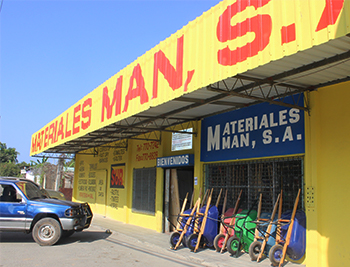
Materiales Justavino is about five minutes drive north of town on the main road, past the “Y” intersection to San Bartolo. Folks call this area “La Cuchilla”. The owner Eivar Justavino, and his wife Eira, provide excellent service and products. This is the only place where I purchase concrete block. I have heard this same report from other expat builders.
Cement Blocks At Materiales Justavino
In our area, many of the hardware stores manufacture their own concrete blocks in tiny open air “plants”, usually in the back of their stores. While other yards skimp on the quality and cleanliness of the sand and cement that they put into their blocks, Sr. Justavino (correctly) predicted that he could corner the rapidly growing expat market for concrete products by maintaining a consistently higher quality than his competitors. He may charge a penny or two more per block than the competition, but it is more than worth the difference in cost, if you take into account the workability, and the greater confidence one has in the finished product.
There is a new ferreteria in town, Ferreteria Los Angeles. It is owned by the same family who owns Supermercado Puerto Armuelles. It is located about half a kilometer further north of town from Casa Cheong and Romero’s Supermarket.
I have only shopped there once or twice , since I like the ferreterias that I already support. I have not found the brothers who run it to be very friendly. However, I have heard good reports about this store from local builders, as well as expats, and I do buy there if one of my three favorite stores is temporarily out of a product that I need that day.
For me, as well as for some other expat builders with whom I have spoken, the idea of getting to shop for supplies right in our own little beach town, just as “in the good old days”, is a privilege that we do not take for granted.
This gift of a happier, easier lifestyle in our little town far outweighs the extra 10 - 20% that we may pay for materials bought from our local supplier in Puerto Armuelles, as opposed to buying them at a home builders center in Bugaba (45 minutes away) or David (an hour and 15 minutes away).
Of course, there are locals and expats who drive to the big super centers, so that they can get the very best price on materials, and perhaps find products that are not available in Puerto Armuelles. Admittedly, I, too, have gone to David to find certain products. Although, it is very rarely these days, since the local stores keep improving their stock (and they can special order anything for you.)
Thankfully, many of us like the idea of supporting the small businessmen and women who are our neighbors, and who help to make Puerto Armuelles the great small town that we have fallen in love with.
My personal conclusion is that if I continually drive to David for specialized materials I will incrementally, shopping trip by shopping trip, be “cashing in” the simple lifestyle that drew me to Puerto Armuelles in the first place.
Sure, I’ll get a better price and more products that I had become accustomed to obtaining in Seattle. But, in the long run, I will wind up with that same lifestyle that had, little by little, become too complicated for me to bear any longer. For myself, and my projects, I have decided that if a certain building material is not available in town, I do not need it. At least I don't need it enough to take my money out of our town, or to complicate my lifestyle like that.
I owned a design/build company in Seattle. One of my greatest professional assets here in Puerto Armuelles is that I don’t have to assign a dollar value to every single minute of my work day. Something I was forced to do back in the States.
I believe that if I shop at my local hardware store, it will stay in business. That way, I will always have the pleasure of shopping at my local hardware store for years to come. I know what life is like in places where all the “mom and pop” hardware stores have closed their doors, due to stiff price competition from the “big boys”. I don’t want to be part of helping that to happen to my new, adopted home town of Puerto Armuelles.
Shopping locally for building products is a win-win decision.
Update: During Panama's coronavirus quarantine, no one is allowed to leave their house on Sundays, including Easter Sunday. Easter 2020 will be very different throughout the world. For those missing community this day, reach out to family and services online. My family is doing a group zoom call on Easter. Your church is likely conducting services online. A Google search will uncover more services and ways to connect. Keep healthy!
It is one of the most popular and celebrated holidays in Panama.
Semana Santa starts on Palm Sunday and ends 7 days later on Easter/Pascua Sunday.
During the weekdays of Semana Santa, the celebrations are noticeable solemn and religious in nature.
But on Holy Saturday and Easter Sunday, only the more religious remain solemn.
For the majority of people, all solemnity is shed on Saturday, esp. Saturday night, and on Sunday.
Come the weekend, spending the day at the beach, clubbing and drinking become the more popular activities. Of course, the powers that be encourage solemnity by banning alcohol sales from Thursday thru Saturday. (For more on alcohol & other bans, read further down.)
Easter is also the last holiday for 6 months in Panama. This could explain why the week-long holiday ends more in a party mode rather than in a solemn religious fervor.
The next holiday is in November. To make up for that 6-month long hiatus, the month of November celebrates 5 holidays.
Semana Santa also often marks the end of summer or the dry season. The rainy season usually begins in late April or in May.
Discover more about Panama's climate and weather.
As I've indicated, Holy Week is a time for special masses, local religious processions dedicated to Mary, Jesus, a Saint, Jesus's last supper, crucifixion, or resurrection.
Every day of the week commemorates different things. I describe the most significant days below.
Palm Sunday - Celebrates Jesus’s return to Jerusalem after his 40-day fast in the desert. His followers laid down palm leaves before him to walk upon.
You won't see that. But you are likely to see people walking around with palms or palms woven into crosses after they leave the church on Palm Sunday.
Holy Wednesday - Church services typically include the reciting of the stations of the cross. Some churches put on a Passion of Christ play (aka Easter Pageant) to dramatically depict the stations of the cross. (Passion in this context means suffering).
The Stations of the Cross: There are 14 stations which represent various milestones of Jesus's last week of life (Holy Week). The first is of Jesus being sentenced to death by Pontius Pilate and the last is of Jesus being laid in his rock-hewn tomb.
Maundy Thursday - Commemorates Jesus's Last Supper and the command he conveyed to his disciples during the meal:
"A new commandment I give to you, that you love one another: just as I have loved you, you also are to love one another" (John 13:34).
For me, this command to love one another is the most important and essential element of Semana Santa.
Some churches have silent processions on this day while others hold reenactments of Jesus's journey carrying the cross. (Note: Maundy is a shortened form of the Latin word mandatum, which means command.)
Good Friday - Commemorates the crucifixion of Jesus Christ. All across Panama, you will find somber and religious processions to commemorate this event.
Some processions have floats, some visit the stations of the cross that parishioners have constructed in various locations on the procession circuit, and some do both.
Whether you are a believer, a photographer, or simply curious, you will find a Good Friday procession in almost every Panamanian town.
Below are photos of people gathering for the Good Friday procession to visit each of the stations of the cross which were created in various neighborhoods.
These photos were taken in Puerto Armuelles, Panama. The photos of the stations of the cross were taken in the day, before the procession. Click on any photo to start the slide show.
Holy Saturday - This is a day in which Jesus was is in his tomb. There is not much to reenact or do with around that. However, as the photo shows, not everyone goes to the beach.
Easter/Pascua Sunday - Big celebration of the resurrection of Christ. The day he rose from the dead. In the States, that is the big day for believers to attend church.
On Easter day in Panama, mass is held, of course. However, in Panama, believers are more likely to attend church multiple times earlier in the week.
The date of Easter changes each year. It can occur anytime from February through April. The exact dates vary in accordance with the lunar calendar.
The following are prohibited from noon on Maundy Thursday thru 6pm on Holy Saturday:
If you want to have a drink during those 54 dry hours, you should purchase your alcoholic beverages before noon on Maundy Thursday.
Like all big holidays in Panama, people pour out of Panama City to go back “home” and then they flood back again. If you can avoid it, do not travel from Panama City into the interior on Wednesday or Thursday or in the reverse direction on Sunday.
Keep in mind, during Easter, Carnival and other big exodus holidays, the government tends to turn the Pan-American highway by Panama City into a reversible lane highway. Which means, trafffic will only be allowed to exit Panama City at the beginning of the holiday. Then when everyone heads back to the city to go to work, the section of the highway near Panama City will only allow city-bound traffic. Check the news before you travel.
Everyone gets a four-day weekend. There are 3 public holidays during Holy Week: Maundy Thursday, Good Friday, and Holy Saturday. Most people also get a half day off on Holy Wednesday too. Mostly, because nobody's mind is on the job before this big family holiday so their employers just send them home.
You will find all government offices and many establishments closed during this 4 to 5 day weekend.
There are a number of foods that are special for the week of Semana Santa.
This article is long enough, so I write about Panama's Easter foods in a different post.
In the last few years, you can find easter decorations and related items in Panama.
But it is not prevalent or even found in all places in Panama. If you are searching for something as specialized as a chocolate Easter bunny, your best options will be found in Panama City or in places where there are a number of expats.
If you want to participate in an egg hunt, your best option may be to host one yourself.
My kids grew up in Panama, creating a more American-like Easter is a challenge. When we first came, I could not even find food coloring to use to dye our eggs. Turned out it was fun to discover our own dyes. We love dying eggs in my family.
To find out what we do, see my article on how on expat kids celebrate Easter in Panama.
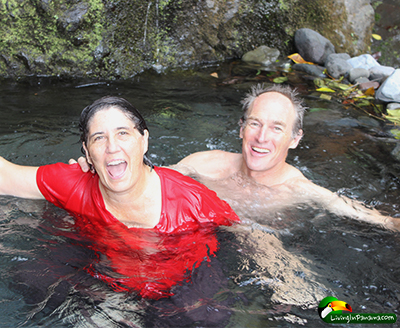
You can see us playing in the river (Rio Macho de Monte) as it runs through the canyon.
The trip reminded me how small and easy it is to explore Panama, and Chiriqui Province in particular.
Business & Pleasure
We wanted to go play in this cool mountain river (see photos), but we also had to meet with a lawyer in David. So we combined the trip.
Day Trip
Home - Beach - City - Mountains - Home again
After Reyn and I returned from our morning surf/boogie board at the beach, all four of us piled in the car. We left Puerto Armuelles at around 10am. We drove to David to meet with the lawyer.
Then we decided to drive past the canon turn off, and go all the up to Volcan to eat lunch. We like the food at Restaurante Mana at the Volcan Lodge. A 15 mile round-trip detour.
After filling our bellies, we went back down to the little village of Cuesta de Piedra, where you turn off to go to Canon Macho de Monte. (I describe how to get there at the bottom of this page and I show what it is like there in photos below.)
We had a delightful and leisurely time playing in the water and boulder hopping. Then we headed back to Puerto Armuelles. We got home before dark (It gets dark around 7pm these days). A very eventful, fun, and even productive day trip.
I had been wanting to check out this canyon for awhile. From the road it is a short walk to the canyon bottom. The trickiest part is that a huge hill of sandy gravel shares the path down, so it is a bit slippery.
In the slow part of the river there were tadpoles that my kids enjoyed catching. A pool to dunk yourself in. Boulders to hop to get to the fissure where the water runs faster and cascades down even further. People have secured a rope right there so you can play in the rapidly tumbling water, but I loved dunking myself in the cold water. Now that I have gone, I want to come back in the rainy season.
The photos below were taken towards the end of the dry season (mid-March). I look forward to going back in the rainy season. I am sure the water flow is much more dramatic and exhilarating.
Take the road up to Volcan. You turn off the InterAmericana onto the Volcan road at the town of Bugaba. There is a sign marking it on the InterAmericana. The turn off for the Canon is at the tiny village of Cuesta Piedra, about 7.5 miles or 12 kilometers south of Volcan.
If you are heading north (or uphill) towards Volcan, there is a sign marking the turn for Canon Macho de Monte in Cuesta Piedra. No such luck if you are heading down from Volcan. The turn is at an intersection with a gas station (photo below) and a few other commercial buildings. You can only turn one way. There is no road going the other direction.
I have put photos below of some key places to look for so you know where to turn, park, and walk.
You will drive on that road for less than 3 kilometers. Look for the guard house for the hydroelectric plant. It will be on your right, as you head down a hill. As you down that hill you will see a ruin of a building on your left (see photo below). Park there. Then walk down the road and take the trail (see photo) just before you cross the bridge over Rio Macho de Monte. As I've said, the trickiest part of the short walk to the canyon bottom is that a huge hill of sandy gravel shares the path down. It is a bit slippery. It is a short walk.
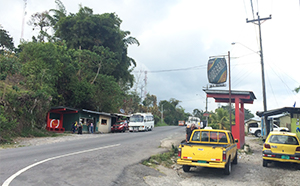
Reyn describes day trips from Puerto Armuelles in a past post. He talks about going for hikes in Cerro Punta.
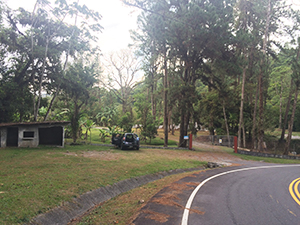
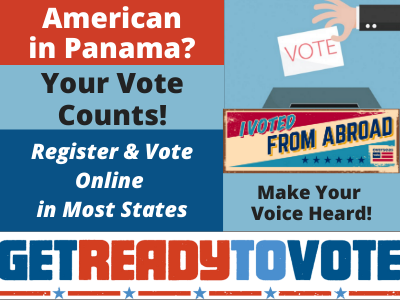
Updated 3/3/20
(Need to get a US election absentee ballot fast? Check out this October 28, 2020 post)
Your vote could be the difference.
All U.S. citizens can receive their ballots electronically.
Depending on the state in which you are eligible to vote, you can get your ballot by email, fax, or online.
[leadplayer_vid id="56D6122A14566"]
This video ends with a pro-democratic party message. I am not suggesting that you vote Democratic. I used this video for its great message, "You can vote from abroad!"
My husband and I have voted in various U.S. Presidential and other elections from Panama.
It wasn't always easy to vote from overseas. Thankfully, it continues to get easier and the number of information sites on how to vote overseas keeps growing.
I have compiled 7 reliable websites on how to register to vote, and how to vote from overseas. Many of these sites also provide information about upcoming elections. Use whichever source you like best.
1) Overseas Vote Foundation is a non-partisan site for US citizens abroad and US military. You can register to vote and request your absentee ballot through this site.
It also offers a wealth of information on the State voting requirements, election dates and deadlines, and contact information. It even includes information on candidates running for election. One thing I like about this site is that it easily lets you vote overseas, even if you are only overseas for a few weeks. This means if you are only out of the country for election day, you will remain registered in your home state, so you don't have to re-register.
Best of all, it offers a Federal write-in absentee ballot. You can use that type of ballot if your requested absentee ballot is late.
2) Democrats Abroad is the official Democratic Party arm for Americans living outside the US.
Democrats Abroad is recognized as a "state" Party by the Democratic National Committee (DNC). It is represented on the DNC by 8 voting members, as well as at the quadrennial Democratic National Convention.
It is a vibrant organization with a presence all over the world, including Panama. During the last Presidential election, they had the first ever online presidential debate between Clinton and Sanders. It focused on issues of interest to US citizens abroad.
From March 3-10, 2020, Democrats can remotely vote in the Democratic Abroad 2020 Global Primary. There are also in-person voting locations on select dates within that time frame.
Find out how to vote in the 2020 Democratic Global Presidential Primary, here.
In 2016, almost 35,000 people in over 170 countries voted in the first Global Presidential Primary. The results of that primary awarded Sanders 9 pledged delegates and Clinton 4 delegates.
3) Republicans Overseas. Good news for Republicans. Until recently there was no website for Republicans overseas. But now there is one: RepublicansOverseas.com. The main goal of the organization is to repeal FATCA. I must say I am 100% behind that effort! Their website also provides some information about voting as a Republican from abroad.
There is also a Republican Overseas facebook page, which has been around for quite a few years.
(Note: Republicans do not allow US citizens to vote in the Republican Presidential primary election while overseas. That is, unless you register in time and subsequently vote via your home state's absentee ballot system. Otherwise, Republican expats can only cast their vote for President in the general election.)
4) Vote from Abroad is a site for US Citizens that allows you to both register and vote from abroad. It also has all sorts of information, such as
5) Federal Voting Assistance Program provides voting assistance to Service members, their families, and US Citizens overseas. It seems to have an easy 5 step process as well as quite a lot of information about upcoming elections.
6) US State Department has a wealth of voting information about voting abroad. It includes a link to an emergency last minute ballot.
7) US Embassy in Panama usually has a message to US citizens about voting abroad and in Panama specifically. For example it explains where and when to submit your US ballots to locations in Panama, or if you can mail them to your home state. To find out the US Embassy's latest advice on voting, click here.
If you have questions about voting in US elections from Panama, the US Embassy Panama Voting Assistance has more information at this link. You can also email them at [email protected].
Remember, your vote counts!"
Maybe because it was so very hot for the first couple of hours this year. But I think the bigger factor was the line up.
[leadplayer_vid id="56D5CE2BC92FA"]
Last year, on Sunday, there more blues performers and the performers were much higher energy. The crowd was higher energy. More people were wearing mardi-gras beads and crazy hats.
Of course, we were also missing Lil Ed and the Blue Imperials. Lil Ed brings his own very enthusiastic head-dress-wearing crowd. But there seemed to be more acts too.
(You can see photos of the 2015 Boquete Jazz & Blues festival here.)
Also missing was face painting and homemade gelato ice cream.
However, there was fabulous pizza baked in a portable wood-fired oven. The ice cream was good, but it wasn't as good as last year's. I loved this year's misters that lightly spayed water on you. They didn't have those last year, that I remember. Did I mention it was so very hot this year.
I enjoyed Tommy Castro very much. He is more R&B than Blues, but his is undoubtedly good. But Sunday's performers weren't the same level of energy and diversity of performers as last year.
Next year, I am will check out the line up more before shelling out the money. I go for the blues, not the jazz. So a good blues line up is critical for me.
Next year's festival will be from February 9 - 12, 2017.
So far the line up looks promising
According to the Boquete Jazz and Blues website, this is the line up.
Regular priced tickets go on sale on April 1, 2016.
I wish they would dedicate Sunday to Blues and Saturday to Jazz. I would sign up for next year right now, if I knew I could be listening to almost all Blues on the day I chose.
For a short time, 2017 Boquete Jazz & Blues Festival tickets are for sale online at a discount. But again, only for a short window of time.
From February 28th 2016, at 6pm until March 2, 2016 at midnight!
The discounted price is $117, which gets you admission for both Saturday and Sunday. Unfortunately, this early out you cannot buy a ticket for Sat or Sunday. You must buy it for both.
To give you an idea of the savings. One day tickets for 2016 were $74. I think the 2 day tickets were $169.
I am not sure if I will buy them early or not. I would have to commit to going for both days. Which could be fun, but I think I would have to leave my kids at home. I don't think they would go for it, at least not happily.
Did you go this year? What did you think?